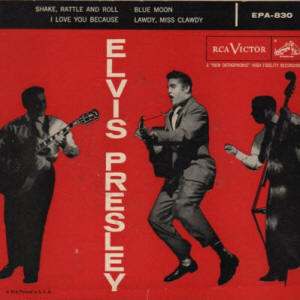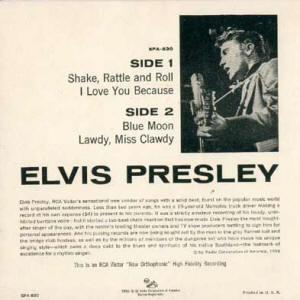Verdict
The combination of two new songs and two lesser known album tracks was an attractive package. Musically "Elvis Presley" was quite versatile, because it offered two uptempo songs and two ballads.
![]()
(C) RCA Victor
The ultimate site about the king of the analogue age


On June 8, 1956 RCA Victor released the third extended player by the name of "Elvis Presley". Billboard selected "Blue Moon" as leading track and listed it on the singles chart "Hot 100" for 17 weeks. It finally peaked at number 55. On the domestic market the record sold more than half a million units, which was honored by the RIAA with a Gold Award in 1992. Translated to the present the physical sales equal 75 million paid streams of the complete ep.
Because all the songs can be found on the albums "Elvis Presley" (1956) and "For LP Fans Only" (1959), Sony Music Entertainment doesn't distribute this extended player via the streaming platforms. In 2016 the complete Presley catalogue was restored and remastered by Vic Anesini for a boxed set of 60 compact discs called "The Album Collection". Sony Music Entertainment provides the streaming platforms with the same versions of the individual albums (in some cases with bonus tracks), albeit in 24 bit/90 khz flac. That means, if the platform of your choice supports high resolution audio, you can enjoy the tracks in the same quality Sony used to scan and master them.
For a wonder the cover doesn't show just Elvis, but also Scotty Moore and Bill Black. This was the first (and final) time the former Blue Moon Boys were presented as a band. The back of the sleeve featured another picture from The Stage Show, the track listing and some liner notes.
The incentive to buy were the new songs "Shake, Rattle And Roll" and "Lawdy, Miss Clawdy". As fillers RCA Victor added two tracks from the album "Elvis Presley". At the time the fans didn't know, that the two new songs would be released on a separate single in August.
Shake, Rattle & Roll
This one is a cover version, too. Joe Turner recorded "Shake, Rattle & Roll" in 1954, the composer is named Carles Calhoun. The rock'n'roll pioneer Bill Haley had the biggest hit with the song, even though he alleviated the lyrics a bit. In his version the lady is in the kitchen instead of the bed and the see-through dress is substituted by a nice hairdo. Elvis also left out the raunchy dress, but the lady was back in the bed and the verse with the one-eyed cat and the seafood store (at the time extremely suggestive paraphrases of the male and femal genitals) was also used. This recording was also made on February 3, 1956 and take 12b was chosen as master take. On the same day Elvis, Scotty, Bill and D.J. overdubbed the backup vocals.
I Love You BecauseIn 1949 composer and singer Leon Payne scored a top5-hit on the "Country & Western Charts" with his song and Elvis also couldn't resist to record it on July 5, 1954 at SUN Records in Memphis/Tennessee. Because Sam Phillips, producer of the session and owner of the label, preferred up tempo songs the tapes were left in the vaults. Steve Sholes used the 3rd and 5th take to create a master, which was released on the album "Elvis Presley" and on a single with "Trying To Get To You". Later RCA also presented outtakes on "A Legendary Performer" (1974) and "The Sun Sessions" (1976). Even though Elvis doesnt sing technically as perfect as in later years, he still delivers an emotional performance.
Lawdy Miss ClawdyLloyd Price had written and recorded the song in 1952. On February 3, 1956 Elvis put 12 takes on tape at the RCA Studio 1 in New York and selected number 10 as the master. I like the song very much, RCA Victor released it in 1959 on the album "For LP Fans Only". Live performances can be found on "Elvis" (1968) and "Elvis As Recorded Live On Stage In Memphis" (1974). In the movie "Change Of Habit" (1969) Dr. John Carpenter (Elvis) plays a few bars of "Lawdy Miss Clawdy" on the piano, a complete version could be seen in "Elvis On Tour" (1972).
Blue MoonIn 1933 Richard Rogers and Lorenz Heart wrote a song called "Prayer (Oh Lord, Make Me A Moviestar)" for a movie named "Hollywood Party". When it was decided not to use it, the duo turned it into "It's Just That Kind Of Play" and tried to get it into the film "Manhattan Melodrama". It was rejected, but another re-write (this time named "The Bad In Every Man") finally made it into the movie. Now it was released, but unfortunately not successful by any means. And so Lorenz Heart wrote a fourth version by the name of "Blue Moon". It was recorded by Glen Gray & The Casa Loma Orchestra and later covered by many other artists. One of them was Elvis Presley, who taped his version on August 15 and 19, 1954 at SUN Records. Take 9 was selected as the master. In general I'm not a fan of the king's early ballads, because he lacked the voice, the depth and the technique to perform them in a believable way. However, "Blue Moon" is one of the big exceptions, because he manages to convince me of his sadness and loneliness and the sparse arrangement is nothing but great. RCA Victor released the song on the album "Elvis Presley" (1956), on a single with "Just Because" (1956) and on the album "The Sun Sessions" (1976).
The combination of two new songs and two lesser known album tracks was an attractive package. Musically "Elvis Presley" was quite versatile, because it offered two uptempo songs and two ballads.
![]()
(C) RCA Victor